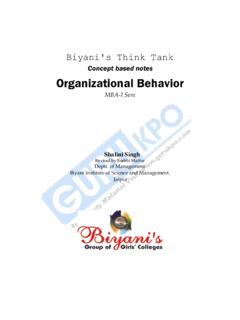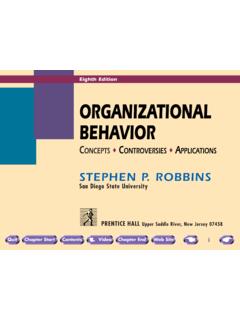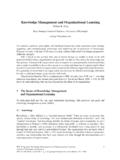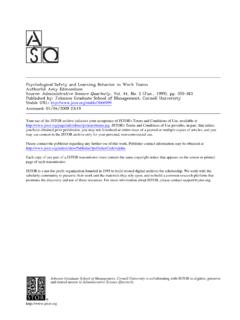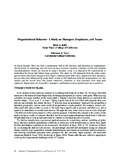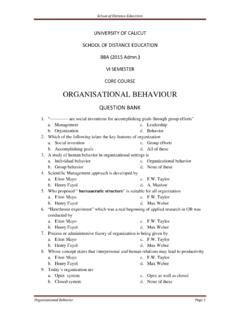Transcription of The impact of organizational culture on employee behavior ...
1 Running head: impact OF organizational CULTUREThe impact of organizational culture on employeebehavior and attitudeByBoniface C. NwugwoMarch 2001 TABLE OF 2 Definition of 5 What is organizational culture ? .. 5 What is Sociability? .. 7 What is Solidarity? .. 9 The Double S Cube 11 Benefits of Sociability .. 12 Drawbacks of Sociability .. 14 Benefits of Solidarity .. 15 Drawbacks of Solidarity .. 16 Review of existing 18 Cultural Influences on behavior and 21 Understanding of the firm s history and current approach .. 23 Commitment to corporate philosophy and values .. 24 Control mechanism for employee behaviors .. 25 employee ethics .. 28 Summary and 33 impact of organizational cultureAbstractEvery organization has a unique culture . Each organization sculture differs from what it values most, what it expects andaccepts from its employees, and how it gets things done. Forinstance, performing the same job for Wal-Mart is different fromperforming it for Sears, as is performing it for Microsoftcompared to IBM, General Electric to Boeing, Dell to Sony, etc.
2 ,etc. The better an employee s needs and expectations fit with therequirements of the culture of the organization the happier theemployee and the organization will be. The more successful thecompany, the more defined its culture tends to be, and the morethat the employee will be expected to either embrace it or culture of the organization to a large extent shapes thebehavior of individuals and groups in organizations. Using theDouble S Cube framework with existing literature on the impact oforganizational culture , this paper examines the effect oforganizational culture on employee behavior and of organizational culture 2 IntroductionAs we march into the twenty-first century, the environmentin which organizations operate is increasingly turbulent, rockedby forces such as globalization and rapid technological and demographic forces have dramatically changed themake-up of today's workforce, which is now the most educated andethnically diverse in history, in addition to having thegreatest representation of women.
3 These developments areprofoundly affecting the way in which organizations organizethemselves, just as they are influencing individuals' behaviorsand attitudes to and expectations of both organizations systems always find ways of controllingbehavior so as to maintain a balance in the system, even whenthat balance may be less than optimal for the organization ssuccess. Some of the ways organizations do this are through theformal and informal cultures in place. Every organization has aculture that sets the rules for employee behavior . culture isthe style or behavior patterns that organizational members useto guide their actions (Cohen, 1993). For example, anorganization whose culture values the initiatives of all itsmembers will have a different climate than an organization inwhich decisions are made by senior managers and enforced byImpact of organizational culture 3their subordinates. The combination of organizational structureand culture drives their book, the character of a corporation (Goffee &Jones, 1998), the authors described four basic cultural formsthat prevails in any organization.
4 The four basic cultural formsare networked, mercenary, fragmented, and communal. Using twovery old and well-established sociological concepts, Sociabilityand Solidarity, the authors developed a framework for definingand understanding organizational culture . They called theframework the Double S Cube, which contains the four differentforms of culture mentioned above, plus four more, thosecultures negative twins . These so-called negative twins arethe dysfunctional cultures that get in the way of business, andsome organizations do have dysfunctional is easy for any form of culture to be functional ordysfunctional. All it takes to slip from the good to the bad isfor people to exhibit the behaviors of Sociability or Solidarityfor their own personal benefit instead of the organization. Togain a full understanding of organizational culture , one needsto understand the positive and negative cultures as well. Forthat reason, both the negative and positive aspects of cultureare included in the framework.
5 In this paper, I would like toexamine the effect an organization s culture has on employeebehavior and attitude. Therefore, the title of the paper will beImpact of organizational culture 4the impact of organizational culture on employee behavior number of studies (Deal & Kennedy, 1982; Denison, 1984;Ouchi, 1981; Posner, Kouzes, & Schmidt, 1985; Pritchard &Karasick, 1973; Sathe, 1985) have already established thatorganizational culture affects employee s productivity,performance, commitment, self-confidence, and ethical there has been a lot of research on the impact oforganizational culture on performance, there has been littleresearch on the effects of culture on employee behavior andattitude. Using the Double S Cube framework and the existingstudies on the effect of organizational culture on performance,my intention is to perform an analysis of the availableliterature, relating the studies to my topic. Based on theanalysis of the existing literature, I would draw someconclusions from those studies as to the impact organizationalculture has on employee behavior and attitude.
6 But as culturemeans different things depending on the context, a definition ofterms with respect to this paper is provided of organizational culture 5 Definition of TermsWhat is organizational culture ? culture is one of those terms that is difficult to expressdistinctively, but everyone knows it when they sense it. Theword culture is used with many different meanings in everydayspoken language and in scholarly literature. Socialanthropologists in the late nineteenth and early twentiethcentury studies of primitive societies used the term culture originally. It was used to describe the primitive societies ways of life that were not only different from the moreindustrialized parts of America and Europe, but were often verydifferent among themselves (Kotter & Heskett, 1992). Formerly,the American Heritage Dictionary defines culture as the arts,beliefs, customs, institutions, and all other products of humanwork and thought created by a people or group at a particulartime.
7 organizational culture evolves from the social practices ofmembers of the organization, therefore, it s a socially createdreality that exists in the heads and minds of members of theorganization as well as in the formal rules, policies, andprocedures of organizational structures. culture is an ongoingprocess of reality construction, providing a pattern ofunderstanding that helps members of organizations to interpretImpact of organizational culture 6events and to give meaning to their working worlds. Thus, culture is an evolutionary and dynamic process that incorporateschanging values, beliefs, and underlying assumptions regardingthe organization (Kropp, 2000).Others (Kotter & Heskett, 1992) see organizational cultureas a two-level process, which differ in terms of theirvisibility and their resistance to change. At the less visiblelevel, organizational culture refers to values that are sharedby the people in a group. These values tend to persist over timedespite changes in the group membership.
8 For example, the notionof what is important in life can vary in differentorganizations. In some settings, people may care deeply aboutmoney, in others about technological innovations or employeewell being. culture at this level is very difficult to change,partly because group members are often unaware of many of thevalues that bind them together. At the more visible level, organizational culture represents the behavior patterns or styleof an organization that persist because new employees areautomatically encouraged to adopt them by their fellowemployees. Those that fit in are rewarded and those that don tare culture can also be viewed as a system. Theinputs to this system include feedback from the society,professions, laws, stories, heroes, values on competition orImpact of organizational culture 7service, etc. The process is based on the organization sassumptions, values and norms. For example, the company s valueson money, time, facilities, space and people.
9 The outputs oreffects of culture are organizational behaviors, technologies,strategies, image, products, services, appearance, is Sociability?Sociability is a measure of the degree of friendlinessamong members of a community (Goffee & Jones, 1998). Sociabilityfocuses on social interaction. Communities with good sociabilityhave social policies that support the community's purpose andare understandable, socially acceptable, and practicable. Sheerenjoyment and comfort of sincere and reciprocal friendship bringthe community is not just a personal life experience, itexists also in workplaces. The level of sociability in anorganization is often the first thing a new employee notices. Asa matter of fact, sociability at the workplace is not muchdifferent from sociability in the private lives. It simply meansthat people relate to each other in a friendly, caring way. Whena co-worker is sick and lands in the hospital, he or she getsflowers and/or personal visits in the hospital by colleagues.
10 Inmost cases, sociability at the workplace extends to havingrelationships outside the office. Co-workers go out after hoursfor drinks in the evenings or on Fridays to celebrate the end ofImpact of organizational culture 8the work week, they spend time together on the weekends, theyjoin the same extracurricular activities, their kids playtogether, and so example of high-sociability relationship is illustratedby a personal experience I had when I worked for anotherdepartment in my current company. A woman that worked in myunit, which consisted of about thirty-five people, was diagnosedof a rare form of kidney disease, and eventually she died fromit. For her funeral, my unit manager rented a van in addition tohis own van to transport thirty-five members to the the funeral, her close colleagues continued to visit herparents who were retired. Having such relationships in thisparticular unit enabled the woman s family to cope with theirloss, and in turn reinforced the commitment of her co-workersand the company.
